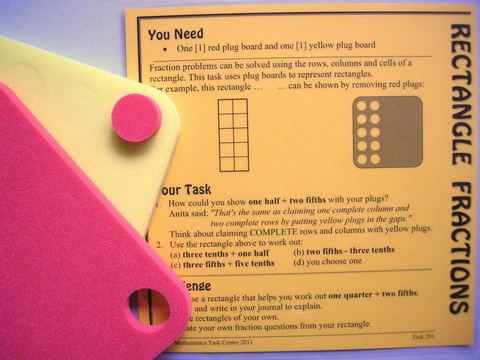
Rectangle FractionsTask 201 ... Years 4 - 8SummaryEvery rectangle is divided into equal parts by its rows, columns and cells. This realisation creates a wonderful model for exploring the concept of fractions, equivalent fractions and addition and subtraction of fractions. The story shell of the task shows that another student can 'see' how to use the model and challenges the reader to try to use their peer's reasoning. The task opens the door to students being able to say: Give me any two fractions to add - all I have to do is imagine the right shape rectangle and I can do it.Teachers wishing to build a curriculum unit around Fractions are likely to find Nichola Brandon's article Fractions In Action worth researching. |
Materials
Content
|

IcebergA task is the tip of a learning iceberg. There is always more to a task than is recorded on the card. |
This task jumps students into the 'deep end' of the rectangle fractions model supported by Anita's insight about how to work these out. Either of the two fractions can be easily shown. One half is a full column. One fifth is a full row, so two fifths is two full rows. However, when they are shown at the same time on the whole rectangle, there must be two points where two plugs have to go on top of one another because the rows and columns intersect. Setting up the addition this way, then moving the 'on top' plugs to an equivalent position models the calculation to give the answer nine tenths. |

Applying this approach to Question 2 gives:
|
Note: This investigation has been included in Maths At Home. In this form it has fresh context and purpose and, in some cases, additional resources. Maths At Home activity plans encourage independent investigation through guided 'homework', or, for the teacher, can be an outline of a class investigation.
- Visit the Home Page for more Background.
- For this specific activity click the Learners link and on that page use Ctrl F (Cmd F on Mac) to search the task name.
Whole Class InvestigationTasks are an invitation for two students to work like a mathematician. Tasks can also be modified to become whole class investigations which model how a mathematician works. |
Poly Plug is an excellent resource to support the development of the rectangle fractions model. However, if you don't have these, blocks on a grid can be used as a bridge between large scale introduction on the floorboard and 1cm graph paper or sketches. Working on the floor with 20cm square scrap card that has been printed on one side is a great way to introduce rectangle fractions. (The 20cm cards are only an example. You may be able to access squares from the art room which are coloured on one side and white on the other, but are still large enough to make a floorboard model.) Hand a card to each student and ask some to make a row of five cards (for example). Now others please add cards to repeat that row so we make a whole rectangle with four rows of five.It's worth mentioning that the reference point for rows is ...across your tummy - like an actor on stage has people in front sitting in rows. In this case the row reference will be the teacher's tummy. So, rows go this way. What word could we use to describe the other direction?Introduce the word columns. So, rows go this way and partition the rectangle into four equal parts. Columns go this way and partition the rectangle into five equal parts. But the rectangle is also divided into equal parts in one other way. What is it?The cards are all the same so they divide the whole rectangle into twenty equal parts (in this example). Introduce the fraction language associated with each of these divisions of the whole rectangle. Now you are in a position to ask questions like the following which make use of the printed side of the cards: Angelo can you turn over one fifth of the cards for me? ... Well done. Turn them back. ... Kathryn can you show me one fifth of the whole rectangle another way? ... How many ways can we find to turn over one fifth of the whole rectangle?Similar questions can be asked for two fifths, three fourths and for rectangles made with different starting arrays. Such oral work can be followed by building the equivalent desk top model with Poly Plug or other material, or using graph paper to make the rectangles. It helps to record in words as on the task card above because this is a direct representation of the oral language. The symbolic language can be encouraged as students become confident with the concept. In fact they often ask if they can 'short cut all of this writing'. This 'investigation' of rectangle fractions is better as a threaded activity, rather than a one or two period 'blitz'. It took the human race thousands of years to understand fractions - why do we try to teach them in a one or two week unit? However, in whichever way you choose to continue you can be guided by the task card and these Free Tour links:
For more ideas and discussion about this investigation, open a new browser tab (or page) and visit Maths300 Lesson 77, Rectangle Fractions, which includes companion software and important Classroom Contributions.
|
Is it in Maths With Attitude?Maths With Attitude is a set of hands-on learning kits available from Years 3-10 which structure the use of tasks and whole class investigations into a week by week planner. |
The Rectangle Fractions task is an integral part of:
The Rectangle Fractions lesson is an integral part of:
|